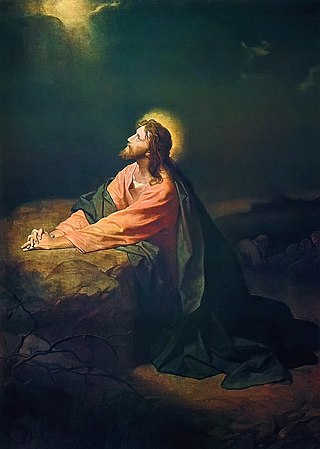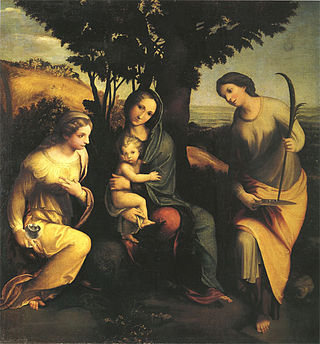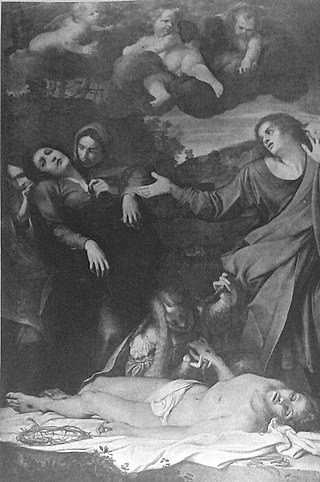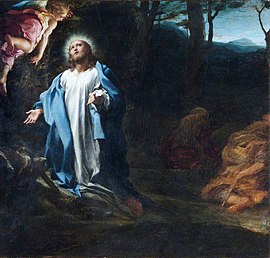
Sisto Badalocchio Rosa was an Italian painter and engraver of the Bolognese School.

Antonio Allegri da Correggio, usually known as just Correggio was an Italian Renaissance painter who was the foremost painter of the Parma school of the High Renaissance, who was responsible for some of the most vigorous and sensuous works of the sixteenth century. In his use of dynamic composition, illusionistic perspective and dramatic foreshortening, Correggio prefigured the Baroque art of the seventeenth century and the Rococo art of the eighteenth century. He is considered a master of chiaroscuro.

Annibale Carracci was an Italian painter and instructor, active in Bologna and later in Rome. Along with his brother and cousin, Annibale was one of the progenitors, if not founders of a leading strand of the Baroque style, borrowing from styles from both north and south of their native city, and aspiring for a return to classical monumentality, but adding a more vital dynamism. Painters working under Annibale at the gallery of the Palazzo Farnese would be highly influential in Roman painting for decades.

Andrea Mantegna was an Italian Renaissance painter, a student of Roman archeology, and son-in-law of Jacopo Bellini.

Reggio nell'Emilia, usually referred to as Reggio Emilia, or simply Reggio by its inhabitants, and known until 1861 as Reggio di Lombardia, is a city in northern Italy, in the Emilia-Romagna region. It has about 171,944 inhabitants and is the main comune (municipality) of the province of Reggio Emilia.

The Agony in the Garden of Gethsemane is an episode in the life of Jesus, which occurred after the Last Supper and before his betrayal and arrest, all part of the Passion of Jesus leading to his crucifixion and death. This episode is described in the three Synoptic Gospels in the New Testament. According to these accounts, Jesus, accompanied by Peter, John and James, enters the garden of Gethsemane on the Mount of Olives where he experiences great anguish and prays to be delivered from his impending suffering, while also accepting God's will.
Carlo Bononi was an Italian painter. An 1876 book lists him among "the last artists of any eminence in Ferrara".

Alessandro Tiarini was an Italian Baroque painter of the Bolognese School.

Lelio Orsi, also known as Lelio da Novellara, was a Mannerist painter and architect of the Reggio Emilia school in northern Italy.

The Nativity is a painting finished around 1529–1530 by the Italian painter Antonio da Correggio. It is housed in the Gemäldegalerie Alte Meister, Dresden.

Adoration of the Christ Child is an oil on canvas painting by the Italian Renaissance artist Correggio, dating from around 1526 and housed in the Uffizi Gallery of Florence, Italy.

San Giovanni Evangelista is a Mannerist-style, Roman Catholic church located on Piazzale San Giovanni, located just behind the apse of the Parma Cathedral, in the historic center of Parma, northern Italy. The buildings surrounding the piazza were also part of a former Benedictine convent. The church is notable for its Correggio frescoes.

The Basilica of San Prospero is a Renaissance-style, Roman Catholic church with a late Baroque-style facade, located on Piazza di San Prospero in central Reggio Emilia, Italy.

Noli me tangere, also known as Christ Appearing to Mary Magdalene in the Garden, is a c. 1525 painting by Correggio which depicts the noli me tangere interaction between Jesus and Mary Magdalene shortly after the Resurrection. It is currently in the collection of the Museo del Prado in Madrid.

The Albinea Madonna or Madonna of Albinea is a lost painting by the Italian Renaissance painter Correggio. The best surviving copy is a 16th-century one by Antonio Leto, from the church of San Rocco in Reggio Emilia and now in the Galleria Nazionale di Parma.

The San Sebastiano Madonna is an oil-on-canvas painting by the Italian Renaissance master Correggio, dating to around 1524 and now in the Gemäldegalerie Alte Meister in Dresden. It measures 265 by 161 cm.

Lamentation was a 1587-1590 oil on canvas painting by Annibale Carracci, destroyed with other Carracci works such as Danaë at Bridgewater House in May 1941 during the London Blitz. Prints and copies of it survive, the best being those by the Ferrara painter Francesco Naselli now in Mantua's city library.

Madonna and Child with Saints is a 1588 oil on canvas painting by Annibale Carracci, now in the Gemäldegalerie Alte Meister in Dresden. Signed and dated by the artist, it is also known as Madonna and Child with Saints Francis, Matthew and John the Baptist, Madonna and Child Enthroned with Saint Matthew and the St Matthew Madonna.

Saint Margaret of Antioch is a 1599 oil on canvas painting by Annibale Carracci, showing Margaret of Antioch. It hangs in Santa Caterina dei Funari church in Rome.

The Lady of Shalott is an oil painting by the English artist William Holman Hunt, made c. 1888–1905, and depicting a scene from Tennyson's 1833 poem, "The Lady of Shalott". The painting is held by the Wadsworth Atheneum, in Hartford, Connecticut. A smaller version is held by the Manchester Art Gallery.



















